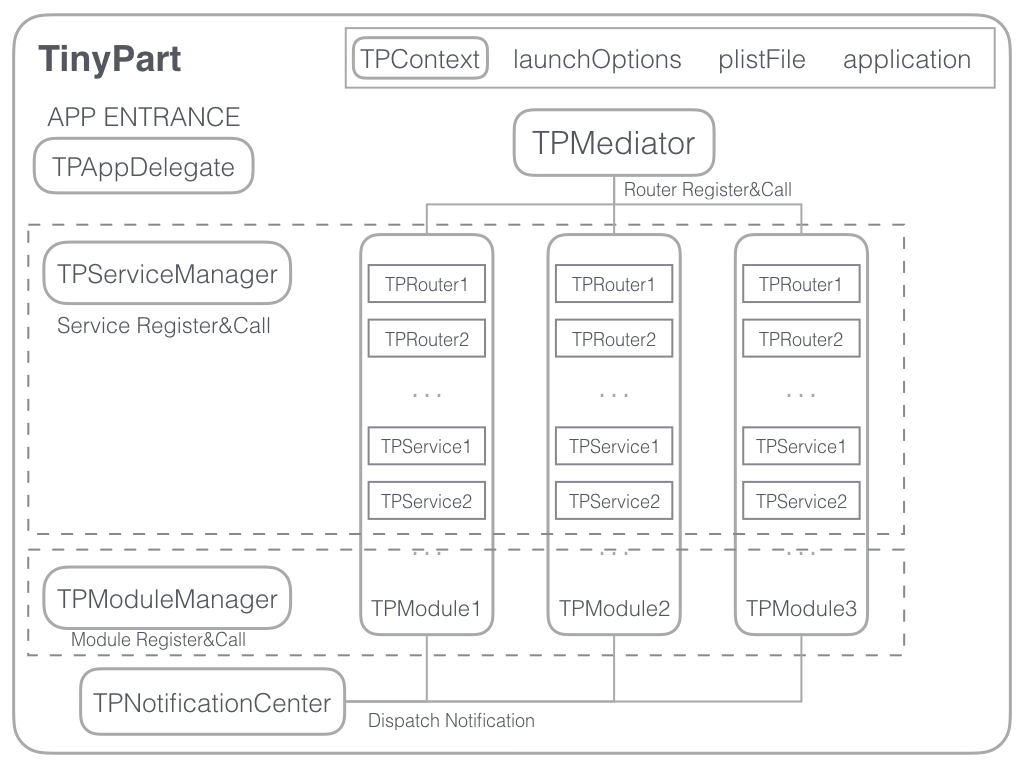TinyPart 是一个由 Objective-C 编写的面向协议的 iOS 模块化框架,同时它还支持 URL 路由和模块间通信机制。
安装
cocoapods
pod 'TinyPart'
特点
- 面向协议。TinyPart中模块和服务都是面向协议的。服务面向协议的好处在于对于接口维护比较友好,任何接口的变动在编译时都是可见的,但是大型项目有可能会面临大量需要维护的协议,这也是不可忽视的缺点。
- 动态化。TinyPart中模块和服务的注册都是在运行时完成的,可以根据具体需要调整模块的注册和启动时间,异步启动模块对于优化APP首屏加载时间会有帮助。
- 路由服务。我们知道面向协议的服务虽然对于接口维护比较方便,但是模块间相互调用各自服务,是需要知道对方协议的,这样最后可能会导致所有的协议需要暴露给所有的模块。比如现在有10个模块每个模块有1个服务协议,在上述情况下每个模块需要知道另外9个模块的协议,这相当于每个协议都被@import了9次,所有协议总共将会被@import 9*10=90次,这对于想做完全代码隔离的模块化来说是个噩梦。通过路由服务则很好地平衡了模块间调用和依赖问题,顺便也解决了跨APP跳转的问题。
- URL路由。在路由基础上,只需要再增加简单的1到2行代码就可以实现通过APPScheme的URL路由机制。
-
多级模块有向通信。一般来说,完全去耦合的模块间通信方案大概是两种:URL和通知
NSNotification。URL解决了模块间服务相互调用的问题,但是如果想要通过URL实现一个观察者模式则会变得非常复杂。这时候大家可能会偏向于选择通知,但是由于通知是全局性的,这样会导致任何一条通知可能会被APP内任何一个模块所使用,久而久之这些通知会变得难以维护。 所谓多级模块有向通信,则是在NSNotification基础上对通知的传播方向进行了限制,底层模块对上层模块的通知称为广播Broadcast,上层模块对底层模块或者同层模块的通知称为上报Report。这样做有两个好处:一方面更利于通知的维护,另一方面可以帮助我们划分模块层级,如果我们发现有一个模块需要向多个同级模块进行Report那么这个模块很有可能应该被划分到更底层的模块。
架构说明

用法
初始化
- 继承 TPAppDelegate,初始化TPContext
#import "TinyPart.h" @interface AppDelegate : TPAppDelegate @property (strong, nonatomic) UIWindow *window; @end @implementation AppDelegate @synthesize window; - (BOOL)application:(UIApplication *)application didFinishLaunchingWithOptions:(NSDictionary *)launchOptions { [TPMediator sharedInstance].deleagate = self; [TPContext sharedContext].launchOptions = launchOptions; [TPContext sharedContext].application = application; context.configPlistFileName = @"TinyPart.bundle/TinyPart.plist"; context.modulePlistFileName = @"TinyPart.bundle/TinyPart.plist"; context.servicePlistFileName = @"TinyPart.bundle/TinyPart.plist"; context.routerPlistFileName = @"TinyPart.bundle/TinyPart.plist"; [TinyPart sharedInstance].context = [TPContext sharedContext]; return [super application:application didFinishLaunchingWithOptions:launchOptions]; } @end
- 新建 plist 文件 'TinyPart.bundle/TinyPart.plist'
模块Module
- 定义并注册一个模块
#import "TinyPart.h" @interface TestModule : NSObject@end @implementation TestModule TP_MODULE_AUTO_REGISTER // 自动注册模块,动态注册模块 TP_MODULE_ASYNC // 异步启动模块,优化开屏性能 TP_MODULE_PRIORITY(1) // 模块启动优先级,优先级高的先启动 TP_MODULE_LEVEL(TPModuleLevelBasic) // 模块级别:基础模块 - (BOOL)application:(UIApplication *)application didFinishLaunchingWithOptions:(NSDictionary *)launchOptions { return YES; } - (void)moduleDidLoad:(TPContext *)context { switch (context.env) { case TPRunningEnviromentTypeDebug: { NSLog(@"%@", @"TestModule1 moduleDidLoad: debug"); break; } case TPRunningEnviromentTypeRelease: { NSLog(@"%@", @"TestModule1 moduleDidLoad: release"); break; } } } @end
如果没有使用TP_MODULE_AUTO_REGISTER 自动注册宏的话,还需要将TestModule1加到TinyPart.plist配置文件中。
服务Service用法
- 定义并注册一个服务Service。Service可自定义单例模式或多例模式。
#import "TPServiceProtocol.h" @protocol TestModuleService1- (void)function1; @end @interface TestModuleService1Imp : NSObject @end @implementation TestModuleService1Imp TPSERVICE_AUTO_REGISTER(TestModuleService1) // 自动注册服务 - (void)function1 { NSLog(@"%@", @"TestModuleService1 function1"); } @end
如果没有使用TPSERVICE_AUTO_REGISTER 自动注册宏的话,还需要将TestModuleService1加到TinyPart.plist配置文件中。
- 访问服务Sevice
idservice1 = [[TPServiceManager sharedInstance] serviceWithName:@"TestModuleService1"]; [service1 function1];
路由Router用法
- 定义并注册一个路由Router
#import "TPRouter.h" @interface TestRouter : TPRouter @end #import "TinyPart.h" @implementation TestRouter TPROUTER_AUTO_REGISTER // 自动注册路由 // APP身份验证,需要实现TPMediatorDelegate中的身份验证回调 TPRouter_AUTH_REQUIRE(@"action1", @"action2") TPROUTER_METHOD_EXPORT(action1, { NSLog(@"TestRouter action1 params=%@", params); return nil; }); TPROUTER_METHOD_EXPORT(action2, { NSLog(@"TestRouter action2 params=%@", params); return nil; }); @end
如果没有使用TPROUTER_AUTO_REGISTER自动注册宏的话,还需要将TestModuleService1加到TinyPart.plist配置文件中。
- 使用路由Router
[[TPMediator sharedInstance] performAction:@"action1" router:@"Test" params:@{}];
URL路由
-
新建
TinyPart.bundle/TinyPart.plist,并注册一条URL Scheme
APPURLSchemes
tinypart
-
定义一条URL路由规则。在已有的
TestRouter基础上,我们只需要新建一个TPMediator+Test的扩展。
@implementation TPMediator (Test) + (void)load { // 声明TestRouter对应的Host TPURLHostForRouter(@"com.tinypart.test", TestRouter) // tinypart://com.tinypart.test // 声明TestRouter中action1对应的Path TPURLPathForActionForRouter(@"/action1", action1, TestRouter); // tinypart://com.tinypart.test/action1 } @end
- 使用URL路由
NSURL *url = [NSURL URLWithString:@"tinypart://com.tinypart.test/action1?id=1&name=tinypart"]; [[TPMediator sharedInstance] openURL:url];
有向通信
-
发送。这里注意前面提到的,底层模块对上层模块的通知称为广播
Broadcast,上层模块对底层模块或者同层模块的通知称为上报Report。模块级别分为Basic、Middle、Topout三个级别。
TPNotificationCenter *center2 = [TestModule2 tp_notificationCenter]; [center2 reportNotification:^(TPNotificationMaker *make) { make.name(@"report_notification_from_TestModule2"); } targetModule:@"TestModule1"]; [center2 broadcastNotification:^(TPNotificationMaker *make) { make.name(@"broadcast_notification_from_TestModule2").userInfo(@{@"key":@"value"}).object(self); }];
- 接收
TPNotificationCenter *center1 = [TestModule1 tp_notificationCenter]; // Observer销毁后自动释放 [center1 addObserver:self selector:@selector(testNotification:) name:@"report_notification_from_TestModule2" object:nil];










